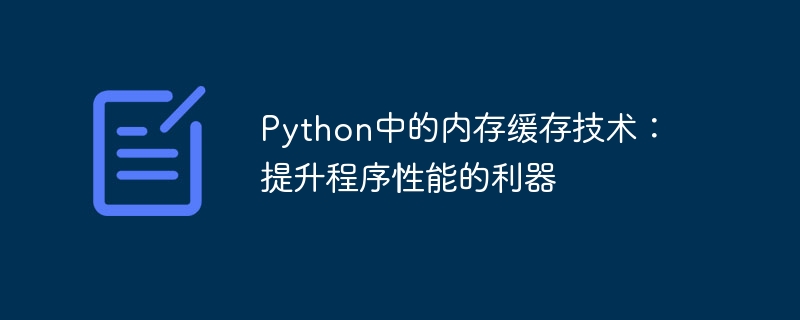

Memory caching technology in Python: a powerful tool to improve program performance, specific code examples are required
Overview:
When writing Python programs, in order to improve the performance of the program Efficiency and performance, we often encounter situations that require frequent database access, network requests, or other time-consuming operations. Each of these operations consumes a lot of time and system resources, and is prone to performance bottlenecks. In order to avoid this situation, we can use memory caching technology to improve program performance.
Introduction to memory caching technology:
Memory caching is a technology that caches calculation results into memory for easy use next time. By saving the results of repeated calculations in memory, you can avoid the waste of time and resources in repeated calculations, thereby improving program execution efficiency.
Implementation of memory caching technology in Python:
There are many ways to implement memory caching technology in Python, including using dictionaries, using decorators, using third-party libraries, etc. Two of the commonly used methods will be introduced below.
The sample code is as follows:
cache = {}
def get_data_from_db(key):
# 从数据库获取数据的耗时操作
# 省略实现
# 使用内存缓存技术获取数据
def get_data(key):
if key in cache:
return cache[key]
else:
data = get_data_from_db(key)
cache[key] = data
return data
# 调用函数
data1 = get_data('key1')
data2 = get_data('key1') # 直接从缓存中获取,无需再次查询数据库In the above code, we use the dictionary cache to save the calculation results. The next time we call the same parameters again, we can Get results directly from the dictionary without querying the database again. This can greatly improve the execution efficiency of the program.
The sample code is as follows:
def cache_decorator(func):
cache = {}
def wrapper(*args):
if args in cache:
return cache[args]
else:
result = func(*args)
cache[args] = result
return result
return wrapper
# 使用内存缓存技术获取数据
@cache_decorator
def get_data(key):
# 从数据库获取数据的耗时操作
# 省略实现
# 调用函数
data1 = get_data('key1')
data2 = get_data('key1') # 直接从缓存中获取,无需再次查询数据库In the above code, we define a decorator cache_decorator, which accepts a function as a parameter and returns a wrapper Wrapper functionwrapper. In the wrapper function, we use the dictionary cache to save the calculation results. The next time the same parameters are called again, the results can be obtained directly from the dictionary.
Conclusion:
Using memory caching technology is a powerful tool to improve program performance. By storing the results of repeated calculations in memory, the waste of time and resources in repeated calculations can be avoided, thereby improving the execution efficiency of the program. In Python, memory caching technology can be implemented using dictionaries or decorators. Choose the appropriate method to improve program performance based on actual needs.
The above is an introduction to memory caching technology in Python, as well as specific code examples. I hope it will be helpful for you to understand and apply memory caching technology.
The above is the detailed content of A powerful tool to improve program performance: memory caching technology in Python. For more information, please follow other related articles on the PHP Chinese website!




